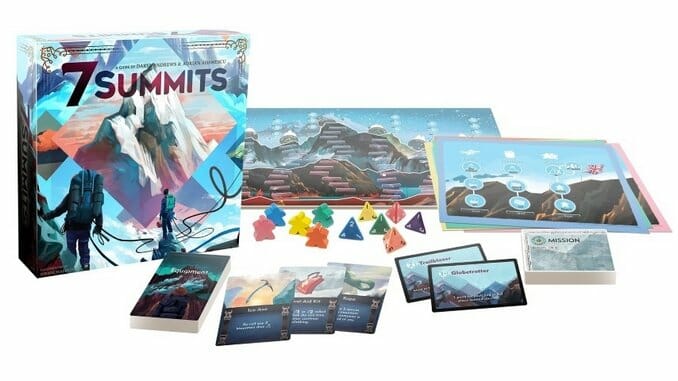Press Your Luck with the Fantastic Board Game 7 Summits
All images courtesy of Deep Water Games
Press-your-luck games have two great selling points: they’re easy for everyone to understand, and that mechanic helps level out the playing field between more and less experienced gamers. The Quacks of Quedlinburg, a game built almost entirely around a press-your-luck mechanic where you’re drawing tokens from a bag, won the Spiel des Jahres a few years ago. Clank!, Port Royal, Codenames, and Half Truth all have some element of push your luck in their rules, but even if you’ve never played any of those, maybe you’ve played blackjack, or Yahtzee, or the stock market—anything where you’re faced with a choice between stopping and banking what you’ve gained so far, or pushing on for greater gains at risk of losing it all.
7 Summits is the newest game from the designer of Sagrada, and it’s a superb, quick-to-learn game with a strong press-your-luck element, but also has room for players who want to try to play it safer and hope other players push their luck and bust. The seven summits of the title are the tallest peaks on each of the seven continents, a challenge for serious mountaineers who also have the means to get to Antarctica to scale Mount Vinson. In 7 Summits, each player has seven meeples and will use dice rolls and bonus cards to try to scale those peaks before other players do, choosing whether to carry on up the mountain at risk of falling all the way to the base with further rolls.
The 7 Summits board shows the seven mountains, with the shortest ones at the left and right edges and Everest in the center. Six of the mountains have their own four-sided dice, and at the start of each round the start player rolls all six of those dice and places them each under their respective mountains. On your turn, you choose one of the six dice and advance your meeple the shown number of spaces, after which you must choose to stop or to ‘press on,’ re-rolling that die while also rolling a six-sided risk die that shows four different outcomes: safety, -1 space, -2 spaces, or a rockslide. If you get one of the safe sides, you move up the number of spaces on the four-sided die and may choose to stop or press on further. The -1 or -2 spaces adjust the die roll by that much, after which you must stop. If you get the rockslide, your meeple drops to the base of the mountain, even if that’s not where you started your turn, and your turn ends. Everest has no die of its own; if you want to try to scale it, you take a die from another mountain and advance that many spaces. To press on, however, you must roll two risk dice.

-

-

-

-

-

-

-

-

-

-

-

-

-

-

-

-

-

-

-

-

-

-

-

-

-

-

-

-

-

-

-

-

-

-

-

-

-

-

-

-








































